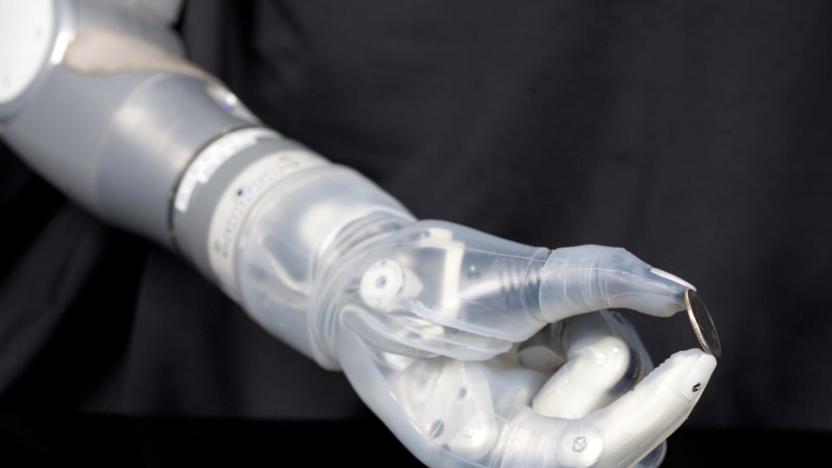arm
Latest

Intel to manufacture ARM chips in a bid for mobile domination
Intel is flexing its manufacturing muscle in an attempt to get inside your next phone. To do that, it has entered a licensing deal with ARM, according to a report from Bloomberg. Without this license, excess manufacturing space goes to waste. But with it, Intel can make processors for Apple, Qualcomm and Samsung -- the biggest players in smartphones. This gives Intel a much-needed boost in the mobile space that it couldn't achieve on its own.

Softbank buys mobile chip designer ARM for $32 billion
Japan's Softbank, which owns US carrier Sprint and many other firms, is set to buy mobile chip company ARM in a blockbuster £24.3 billion ($32 billion) deal. The UK company designs the processors used in virtually every mobile device, including most models from Apple, Samsung and HTC. While it doesn't build them itself, it licenses the tech to Qualcomm, MediaTek, Samsung and others. If the deal goes through, it would be one of the largest acquisitions of a European tech firm ever, and a vote of confidence by Softbank in ARM's business in post-Brexit UK.

Segway creator's advanced prosthetic arm arrives in late 2016
Segway creator Dean Kamen's Luke prosthetic arm has been a long time in coming -- the FDA approved it two years ago. At last, however, it's nearly here. Mobius Bionics has revealed that it will offer the Luke arm sometime in late 2016. It's not clear what it will take to get one (you can register your interest today), but the features remain the same. The bionic wearable is all about offering the life-like dexterity that hasn't really been an option until now: you can hold a glass over your head without spilling it, for example, and the hand's mix of four motors and grip sensors can help you grab both very delicate and very heavy items. The odds are that getting one won't be trivial, but it might well be justified if it grants some extra freedom.

Amazon robot challenge winner counts on deep learning AI
Amazon's robot Picking Challenge is back for a second year, and it's clear that the competition has learned a lot in that time... in more ways than one. The Netherlands' TU Delft won both parts of the challenge (stowing and picking warehouse items) with a robot that relied on the combination of deep learning artificial intelligence and depth-sensing cameras to get the job done. The machine studied 3D scans of the stockroom items to help it decide how to manipulate items with its gripper and suction cup. That adaptive AI made a big difference, to put it mildly. The arm got a near-flawless score in the stowing half of the event, and was over three times faster at picking objects than last year's champion (100 per hour versus 30).

Tattoo artist's prosthetic inking arm is better than a real hand
If you wanted to be a tattoo artist but lost your drawing arm, what would you do? JC Sheitan Tenet has an answer: get a prosthetic arm that's better than flesh and bone. He teamed up with artist Gonzal on a steampunk-inspired limb that integrates an inking needle, a pressure gauge and piping. It's a makeshift combo of a regular prosthetic, a sewing machine and a turntable, but it's reasonably light and easy to use -- so much so that you might prefer JC's mechanically-assisted output over that of a good conventional artist.

ARM prepares for VR in 2017's phones with new chips
Come next year, ARM has one major theme in mind for its next batch of mobile processors: virtual reality. Its new Cortex-A73 chip and Mali-G71 GPU are, naturally, faster than its current lineup. But more so than the past few years, where incremental improvements were enough, ARM sees VR as the ideal goalpost for its chips. The new Mali chip, for example, will be able to push up 4K screens with refresh rates of up to 120Hz (90Hz is the bare minimum for decent VR). And both new processors will also be easier on battery life, which means you'll be able to stay jacked into virtual worlds for much longer.

NASA wants your ideas for its cube robot's arm
Think you could build a better robot arm than NASA? You now have a chance to prove it. The agency is teaming up with Freelancer to crowdsource ideas for the arm on Astrobee, a cute cube robot that will float around the International Space Station monitoring conditions and supplies. The first phase will have NASA pick the top 30 entries that meet some basic criteria. If you pass muster, you'll be asked to break down the architecture options for your design. Do that and NASA will run another crowdsourcing effort to solicit ideas for the subcomponents from those 30 submissions. Phew.

ARM's latest design brings 64-bit processors to smartwatches
It's no longer hard to find 64-bit processors in smartphones. In smartwatches, though, they're still a rarity -- and ARM wants to change that with its new Cortex-A35 processor design. The architecture promises the most energy-efficient 64-bit mobile chips yet, sipping 32 percent less power than the mid-range A53 even as it outruns the Cortex-A7 it's meant to replace (6 to 40 percent faster). It's extremely scalable, too. You can build full-fledged quad-core chips for entry-level smartphones, but you can also strip things back to make tiny chips for watches and activity trackers.

Eye-tracking robot arm lets you paint while you eat
One day, you might not have to even touch a canvas to make a masterpiece. Scientists from Imperial College London have developed a system that lets you paint hands-free through a combination of eye tracking and a robotic arm. All you do is adjust your gaze and blink at the right times -- you can even munch on breakfast while you're in mid-oeuvre. The technology is crude at the moment, but it should eventually become intuitive enough that you can focus on perfecting your style, rather than mastering the basics.

ARM's latest graphics core will speed up your smartwatch
Let's be blunt: the graphics in most smartwatches suck. They're frequently limited to basic effects, and you'll sometimes see the kind of stuttering that has long-since disappeared on your smartphone. ARM aims to fix that, however. It's launching the Mali-470, a mobile graphics core that's virtually tailor-made for smartwatches, the internet of things and anything else where battery life is the top priority. The GPU supports the flashy per-pixel visual effects you see on modern phones (OpenGL ES 2.0, to be exact), but it uses half as much power as the long-serving Mali-400 even as it runs faster-- you could see lively 3D animations that don't kill your watch within a few hours.

Meet the Micro:bit, the BBC's tiny programmable computer for kids
The Raspberry Pi has been a huge success story for Britain, giving millions of people an affordable way to tinker and learn with pocket-sized hardware. Now, the BBC is hoping to make a similar impact with the "Micro:bit." Like the Raspberry Pi, this tiny computer has been created to help youngsters learn the fundamentals of programming and computer construction. Today in London, the broadcaster unveiled the Micro:bit's final design -- a rectangular, credit card-style board measuring 4cm by 5cm -- and some of the all-important hardware features. These include 25 red LEDs, which can show messages and facilitate games, two programmable buttons, an on-board accelerometer and magnetometer. The device also offers Bluetooth LE connectivity, a microUSB slot and five input and output (I/O) rings that can be hooked up with crocodile clips and 4mm banana plugs. It's been a while since the original BBC Micro was considered cutting edge, but even so -- this new device is roughly 18 times faster and 67 times lighter than its spiritual predecessor.

ARM makes another stab at boosting the Internet of Things
ARM's been championing the Internet of Things for several years now, and for good reason: it's poised to win big as more devices tap its low-power chips. Last year it unveiled an Internet of Things platform, now at Computex it's targeting device makers and its chip building partners by announcing an IoT subsystem for its Cortex-M processors. Basically, that means it'll be easier for semiconductor companies to take ARM's designs and build chips that are ideal for connected devices, while also integrating ARM's mbed IoT platform. The company also announced its new "Cordio" low-power radio, which runs below 1 volt and packs in Bluetooth 4.2. Dipesh Patel, ARM's EVP of technical operations, noted that Cordio will be ideal for extremely low-power connected devices like beacons. All of this may seem a tad dull, but if ARM wants the whole Internet of Things ecosystem to take off, it's essential for ARM to make it as easy as possible to build for it.

Smartphone chips are about to get better at gaming, Twitter and Netflix
There's been a lot of talk about how phones from certain manufacturers can sense when you're running benchmarking software and will artificially inflate their performance accordingly. It's been a problem for some time now, but the industry appears to be finding its own ways of dealing with the issue. ARM, the outfit that designs the bulk of the smartphone industry's chips, has teamed up with British startup GameBench to make benchmarks not only more honest, but also a lot more understandable.

ARM's latest processor design puts fast 4K graphics on your phone
You've probably heard no end of hype for 4K video on TVs and computers, and now it's about to invade your phone... at least, so long as ARM has its way. The company just took the wraps off of Cortex-A72, a processor reference design that promises a huge boost to computing power, especially when graphics come into play. Thanks to updates that include optimizations for an efficient 16-nanometer chipmaking process, 30 percent more memory performance and an 80 percent speedier graphics core (the Mali-T880), the A72 is about 3.5 times more powerful than ARM's earlier Cortex-A15. That's beefy enough to record 4K video at an extra-smooth 120 frames per second -- many current smartphones only manage 30FPS at best. You should get "console-class" gaming, too, and there's a promise of Google Now-style natural voice commands that don't depend on a distant server to interpret what you're saying.

DARPA-funded mind-controlled robotic arm now works a lot better
At Expand NY in November, DARPA Director Arati Prabhakar talked about the erm, friendlier projects the agency is funding, including a mind-controlled robotic arm tested by Pittsburgh native Jan Scheuermann. Her test run has recently ended, but the University of Pittsburgh researchers in charge of project have published a paper detailing how much the limb has improved over the past two years. Before they took off Jan's implants, she could already move not just arm itself, but also its wrist and fingers -- she reportedly even beat her brother at a rock-paper-and-scissors game. "Overall, our results indicate that highly coordinated, natural movement can be restored to people whose arms and hands are paralyzed," said Pitt School of Medicine professor Andrew Schwartz, Ph.D.

Qualcomm wants to get into servers after conquering the mobile world
Qualcomm is sitting pretty right now. Its Snapdragon processors and cellular chips are present in most of the big-name mobile devices you can use today, whether it's the Nexus 6 or the iPhone. However, the company isn't content to stop there -- it just confirmed plans to launch its own line of server processors. CEO Steve Mollenkopf isn't offering many details just yet, but it won't surprise you to hear that these heavy duty CPUs would be ARM-based like their mobile counterparts. There's no timing yet, either, although the exec adds that his firm is already "engaged with customers."

LG's next phone will be the first with one of its own CPUs inside
LG has been trying for years to catch up to Samsung and Apple in phone sales, and its next step on that path is to make a device with an LG CPU inside. The G3 Screen phone that it's releasing this week in Korea will have an eight-core "NUCLUN" (pronounced NOO-klun) processor, based off of an ARM big.LITTLE design similar to Samsung's octacore Exynos chips. NUCLUN has four 1.5GHz cores for the tough tasks, and four 1.2GHz cores for easier stuff that help it save on battery life. Otherwise, there's also a 5.9-inch 1080p screen and support for the new, faster LTE-A networks that download at up to 225Mbps. Until now, LG's phones have mostly relied on Qualcomm chips for their processing needs, but Dr. Jong-seok Park believes going its own way will help the company "achieve better vertical integration" and greater flexibility going forward. Of course, we're wondering when a NUCLUN-powered phone will go on sale outside of Korea, but considering the progression of Exynos, that could take a while.

ARM attempts to speed up 'internet of things' adoption with new platform
It's the year 2014, and we've yet to have our flying cars and commuter jet packs. But we do have a glimpse of the future with the advent of the "internet of things." It's essentially the idea of connecting everyday objects -- be it thermostats or kitchen appliances -- to the web, in an effort to make our lives easier. As wonderful as that sounds though, development of new IoT technologies can be slow, due in part to the multiple different protocols in existence today and how tiresome it is to create an ecosystem from scratch. That could soon come to an end, however, thanks to ARM. The chipmaker has just announced a brand new IoT-specific device platform that includes both a free operating system (tailor-made for ARM's Cortex-M processor based devices, of course) plus a server-side software product that ties it all together. Based on the mbed hardware and software ecosystem, the platform basically gives manufacturers the tools and building blocks necessary for IoT devices and services, thus making it that much faster and cheaper for them to bring their ideas to fruition.

ARM's new processor will add oomph to smart appliances and drones
If you have any smart device -- be it a phone, tablet, router, wearable or otherwise -- there's a good chance ARM's Cortex lineup is responsible for the brains behind the scenes. The company just announced the latest processor in its M-series, which is a set of low-power processors capable of handling embedded devices like smart home appliances, drones, automotive and wearables, which is focused on making said devices even more powerful. The M7, as it's called, comes with a 400MHz processor, packing more than twice the punch as the 168MHz M4 that came before it (and will continue to be available to manufacturers). It comes with support for more displays, motors, voice controls, connectivity, audio performance and improved GPS accuracy. In other words, the infamous Internet of Things should become even stronger and more powerful. ARM says that manufacturers are already building devices with the chip embedded, so it won't be long before we get to see if the extra power actually makes a difference in our everyday lives.

NVIDIA explains why its 64-bit chip should be Android's speed champ
NVIDIA set out to claim the Android performance crown when it unveiled its 64-bit Tegra K1 processor at the start of the year, and it's now ready to explain why it expects to come out on top. The chip's two Project Denver cores will have an edge partly because they'll optimize code on the fly -- they'll break down big instructions into tiny, super-efficient functions that can be recycled as often as necessary. The company expects roughly twice the speed it would get from ordinary code, making the 64-bit K1 faster than you'd expect just by looking at the hardware. It should tout "significantly higher" performance than current four- and eight-core mobile CPUs, and run as well as some PC processors; be prepared for more Tegra-powered laptops and high-end tablets.








